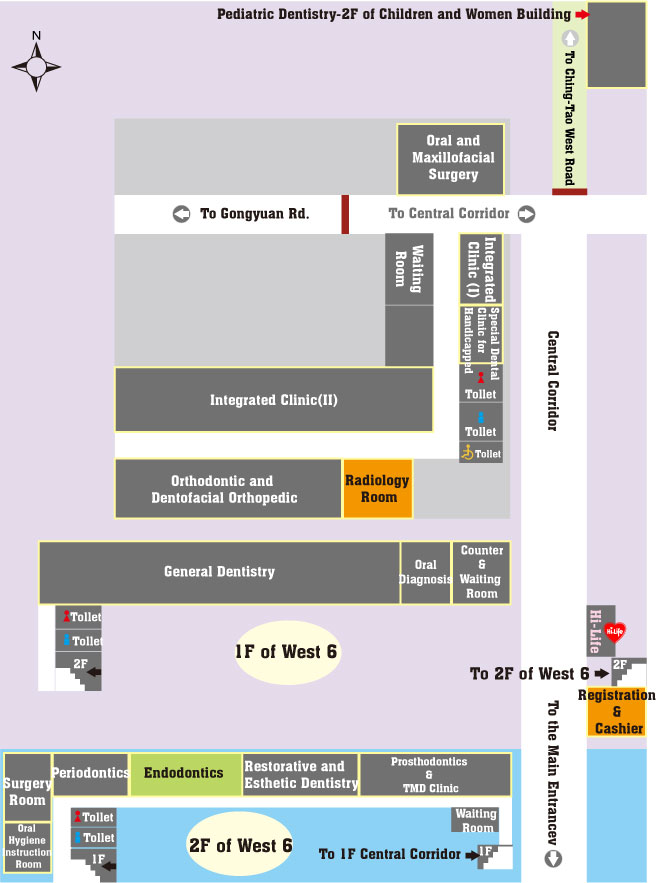Introduction
Department of Dentistry in National Taiwan University Hospital was founded with 20 dental chairs in 1959. Two of them were planed for endodontic therapy exclusively. Such a formulation mainly focused on long-term development of Dept. of dentistry and braced for the age of specialized treatment. On the other hand, we also nourished people of talent in order to invent in clinical practice and education.
In 1980, the clinical service of Endodontic specialty in Dental department was established. In addition, ultrasound and apex locator application were also established at that time.
In 1995, in order to follow the worldwide trends and meet the needs of clinical applications, the dental department of NTUH was subdivided into several divisions. Endodontic department has become one of the subdivisions of NTUH dental department officially. Currently, we have outstanding accomplishments and exceptional achievements in both clinical dental treatment and basic research, which attract many dentists entering our post-graduate and specialist training program. In the future, we will dedicate to establishing qualified and excellent endodontic treating environment, cultivating outstanding endodontic specialist, and becoming the well-known leading endodontic clinical and research center in the world.
Staff
Full time staff:Dr. Jiiang-Huei Jeng; Chun-Pin Lin; Yuan-Ling Lee; Yi-Ling Tsai
Part-time staff
Resident
Services
Patient Care
In endodontic department, we mainly treat teeth that have pulp diseases. Generally speaking, endodontic treatment can be classified as conventional and surgical root canal therapy. Most of the pulpal and periapical diseases can be treated by conventional root canal therapy. In some cases for which conventional treatment cannot cure the disease, or when there is larger osseous lesion in the periapical region, surgical endodontic treatment is considered as an alternative choice by removal of a portion of root apex and retrofilling of the root canal by biocompatible materials during apical surgery. In addition, if there are crack lines on the root or if root fracture is noted, we can remove the fracture root fragments by hemisection or root amputation. As to the treatment for pulp-related diseases, such as deep caries without pulp involvement, we can preserve the pulp vitality by pulp capping procedures. As to teeth with crack tooth syndrome, we can protect them by preformed band. When the teeth are dislocated and avulsed because of traumatic injury, early replantation and temporary splinting of affected teeth can be done. The teeth with severe dentinal hypersensitivity can be desensitized by adequate medicaments or sealing the dentinal tubules by various lasers to improve the symptom.
Device for therapy
Image system:
During endodontic therapy, we need to take many radiographic photos with multiple angulations. In our department, we use digital image system. One of the advantages of the digital image system is to decrease the exposure of radiation of patients. According to the reports, the dose of radiation in digital system is one-tenth of conventional radiographic system. It is more convenient to manage or store the image data, too.
Device for micro-surgery:
In 1996, base on teaching and clinical needs, the endodontic department of NTUH recommended the first dental operative microscope in Taiwan. Under the magnification, identifying the canals orifice, removing separated instruments, and repairing perforation become much more easily than before. Operative microscope combined with endodontic surgery result in decreasing tissue damage and improving wound healing. It markedly improves the Endodontic treatment outcome.
Ultrasonic instruments:
In endodontic field, the ultrasonic instrument is used primarily in irrigation and sterilization of root canals. It can also be used to remove posts, old root canal filling materials, and separated instruments by its special vibrating motion. In endodontic surgery, ultrasonic instruments with special designed tips can make every step precisely done. Because the size of ultrasonic tip for microsurgery is designed to be much smaller, destruction of the healthy root structures can be minimized. This can promote wound healing after apical surgery and decrease postoperative discomfort.
Rotary Ni-Ti instruments:
Traditional stainless steel hand instruments have been used for root canal enlargement for more than 30 years. Recently, flexible Ni-Ti rotary instruments has been developed and used in the Endodontic department since 1999. The advantages of Ni-Ti rotary instruments are the motor with constant RPM combined with super-elastic and shape memory properties of NiTi alloy. It can cut efficiently, follow the original shape and curvature of root canal, as well as remove the infected tissue and tooth substances. Ni-Ti rotary instruments make root canal therapy rapidly and efficiently.
Thermoplastic obturation equipment:
After thorough cleaning, dense root canal obturation is one of the keys to successful treatment. In addition to the traditional lateral compaction equipment, Endodontic department introduced thermoplastic obturation equipment. In some teeth with irregular root canal system, such as external root resorption, internal root resorption etc, the root canal system can be adequately obturated by thermoplastic obturation technique. Therefore, it would be a tremendous choice.
Dental Laser:
Concomitant with advances in technology, the use of laser in dental therapy received more attention. The research for dental laser in endodontic department has done for more than ten years, including dentin desensitization, soft tissue management, the prevention of dental caries, the detection of dental caries and cleaning for canals etc. All of these researches have already got good result.
Map

Clinical Session
Clinical session-Register on the internet
Contact Information
Tel|(02)23123456 ext 67405/67406
E-mail|dental@ntuh.gov.tw